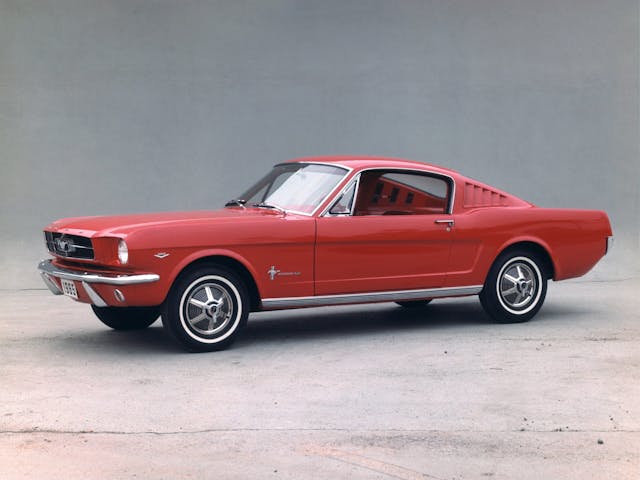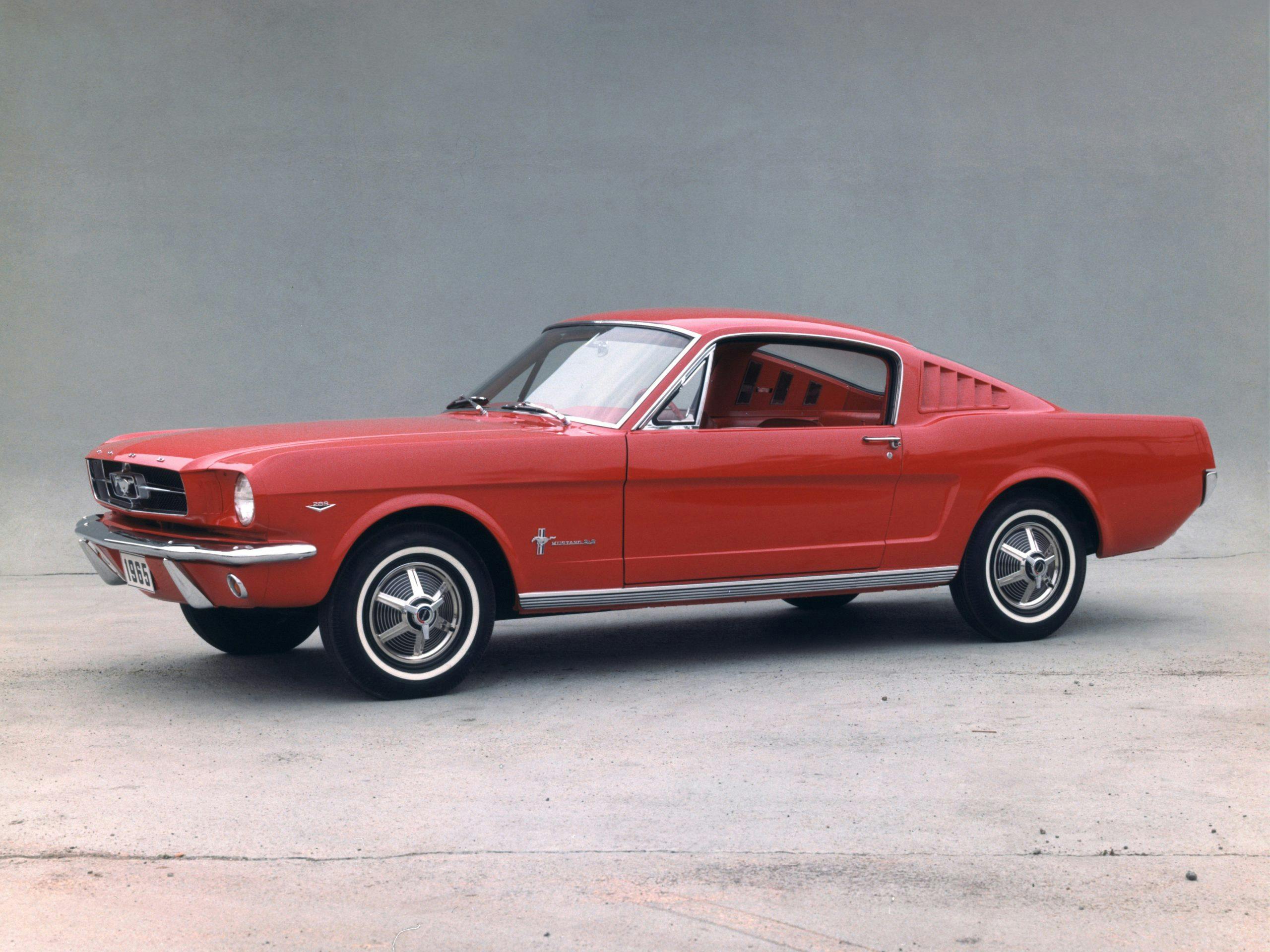Media | Articles
Your handy 1965–66 Ford Mustang buyer’s guide
If one car embodies 1960s Americana, it’s the 1965–66 Mustang. The compact dimensions, smart styling, affordable asking price, and plethora of options spread across three body styles means that there’s an iteration of the original pony car to suit your fancy, no matter your budget or background.
Which Mustang is right for you, though? Let’s dig deep into the history of the 1965–66 Mustang, highlight tips for finding and addressing problems, and discuss the latest pricing trends using Hagerty Valuation data. As always, we appreciate having your tips, tricks, and feedback in the comments section!
1965
Introduced in 1964 with a base price of $2368, the Mustang was offered either as a hardtop or as a convertible. All 1964–65 Mustangs wore a VIN designation proclaiming production during the 1965 model year—even if they rolled off the assembly line in ’64. The full year of production also introduced the popular fastback body style. Priced between the hardtop and convertible, the fastback sported a wildly sloped roofline with unique rear glass and deck lid, giving the Mustang a more performance-oriented look compared to the hardtop coupe.
The entry-level Mustang had standard bucket seats, a sporty floor-mounted shifter, and Ford’s 170-cubic-inch “Special Six” inline-six engine mated to a three-speed manual gearbox, with an optional four-speed manual or Cruise-O-Matic automatic. Upgrading to a V-8 was possible via a 260-cu-in small-block (F-Code) or two versions (D- and K-code) of Ford’s famous 289-cu-in V-8: The top, K-code model cranked out 271 hp, making it the most desirable of the breed thanks to its aluminum pistons, solid lifters, high-flow cylinder heads, heavy-duty crank, larger carburetor, and chrome valve covers and air cleaner. While K-code cars are rare and highly prized, a slew of performance options gave customers the opportunity to spec any Mustang to a higher-performance configuration. Choices included front disc brakes, a special handling package with retuned shocks/springs/enlarged front sway bar, and even a limited-slip differential.

Making the Mustang unique to each customer was simple. Ford offered a wealth of colors and optional equipment: paint stripes on the rocker panels, push-button AM radio, day-night mirror, two-speed wipers, remote-control sideview mirror, padded sun visors, wire wheels, white or red line tires, and even a vinyl roof. Other options are notable for their value and curb appeal: rally pack gauges with integrated clock and tachometer, an elegant full-length console, power steering, power brakes, and (of course) factory air conditioning mounted below the dashboard.
Marketplace
Buy and sell classics with confidence
The new Mustang was used as a pace car for the 1964 Indianapolis 500. Ford made 190 hardtop replicas available to dealerships on a limited basis, finished in Pace Car White with blue interior trim and equipped with the F-code V-8. It also made 35 D-code convertibles, which were used at the ’64 Indy 500 and sold through Ford’s retail channels afterwards.

There’s controversy surrounding the decision to classify Mustangs made in 1964 as 1965 models, since both production years share the VIN designation of the 1965 model year. Whichever side of that debate you take, there were 121,538 Mustangs made in 1964 and a whopping 559,451 in the full year of 1965.
The “true” 1965 Mustangs sported several changes: The base 170-cu-in I-6 was replaced with a larger 200-cu-in version, and the base 260 V-8 was swapped for a C-code 289. There was a new middle-of-the-road, A-code 289 as well, but the K-code V-8 remained the top option. All engines now had alternators in their charging systems instead of a generator. Also new for 1965 was a GT Equipment Package; cars so equipped are easily identified by grille-mounted fog lamps with either the A-code or K-code engine behind them. The GT also included a five-pack instrument cluster, rocker panel stripes, a special handling package, and disc brakes. A special “Pony Interior” made production midway in the 1965 model year. This decor group included ponies embroidered on the seat backs, more luxurious seat bottoms and door panels, wood grain accents on the console and dash, the five-pack gauge cluster, and even a simulated walnut steering wheel.
1966

Changes in the second year of production were limited—and rightly so, as the Mustang passed the 1 million unit production mark this year. You can spot a 1966 Mustang by its grille texture, chrome hood molding, redesigned gas cap, new wheel covers, upgrade from 13″ to 14″ wheels (six cylinder models only), standard five-pod gauge cluster, redesigned side-scoop brightwork, and chrome panels over the rocker panels (deleted on GT). Federal mandates meant that the once-optional reverse lamps were now standard. The previous year’s extensive list of optional equipment was also present in 1966, with the addition of an optional 8-track cassette tape player.
There were several special-edition Mustangs in 1966: Commemorating the sale of 1 million Mustangs, Ford created 50 units of the Anniversary Gold hardtop, finished in “Anniversary Gold” paint, powered by the C-code 289 two-barrel V-8, and optioned with the Pony Interior upgrade. The 1966 “Sprint 200” edition gave Mustangs not ordered with a V-8 some extra flair: a chrome air cleaner and painted accent stripes (matched to the interior color) along with the usual options available to six-cylinder Mustangs. Sprint 200 interior upgrades included a center console with courtesy lights.

The final special edition, the Colorado-only “High Country” edition, started the trend of regional Mustangs with cosmetic upgrades. High Country Mustangs were finished in Columbine Blue, Timberline Green, or Aspen Gold, and sported blue crests near the Mustang fender emblems. High Country models were available with any body style and powertrain combination, and only 333 copies were produced.
If you’d like to read more about the entire first generation of Mustangs, we got you covered. For everyone else, let’s learn about what to check when buying a ’65–66 Mustang.
Before you buy

Find a 1965–66 Mustang that fits the bill is likely easy, but ensuring that its condition is acceptable can be more difficult. Since the Mustang is a unibody chassis (the body and frame are welded into a single component) your biggest concern will be rust, especially in a structural location. Rust can lurk in the floor boards, frame rails, the lower portion of the doors, the trunk lid, below the windshield (cowl vent) and rear window, under the battery, and in even lower sections of the shock tower.
Even rust repair can be suspect. Be weary of poorly repaired areas that use fiberglass patch panels or copious amounts of body filler to achieve a smooth surface. Confirming that the doors close nicely is a good start (especially on convertibles), but remember that a Mustang with rust issues may still be worth purchasing: There’s a cottage industry dedicated to reproducing everything, including sheetmetal.
After assessing the condition of the chassis, evaluate the condition of rubber parts in the suspension, the powertrain, and the body. Since most replacement rubber is readily available, factor in the cost of new weatherstripping—or a leaky hose or cracked bushings—when considering the vehicle’s asking price. Don’t forget the age of tires, either: Almost any tire loses the majority of its performance potential after a decade (though usually before that).

Combining the tips above with a test drive and a test of all features (lights, gauges, wipers, seat belts, HVAC, etc.) shall yield an accurate assessment of the Mustang’s condition, and equip you with enough information to determine whether the asking price is fair. When in doubt, hire a professional automobile inspector to give you a full report.
Now, for the final question. Is authenticity a concern?
Everything from factory air conditioning to Pony Interiors (even fastback sheetmetal!) can be added to a less desirable Mustang over the years. Thoughtful checking of part numbers and factory stampings will be necessary to ensure you’re buying a Mustang with pedigree. Avoid sellers asking for top dollar who don’t provide the paperwork proving their cars’ authenticity, originality, and condition.
Perhaps you’re not concerned with originality—you just want a driver-quality Mustang. In that case, these rules should be far more flexible. Take advantage of the robust aftermarket selection and add features that would hurt an example with a pedigree; there’s plenty of room to improve your ownership experience without diluting the Mustang’s signature style. The aforementioned air conditioning and Pony interiors are a good place to start, but even feature-packed “retro” audio systems, disc-brake conversions, overdrive transmissions, electronic ignition (maybe even fuel injection!), and upgraded suspension parts are worth considering.
Valuation

The Hagerty Valuation team has gained significant insight in to the recent transaction prices for 1965–66 Mustangs, but please check here for the most up-to-date values. While many muscle cars tanked in value during the last recession, Mustangs weren’t nearly as volatile: other than a slight dip in 2009–10, they’ve been trending upwards with small movements rather than big surges. Values of #2-condition (Excellent) 1965 Mustang stayed flat in the most recent (January 2021) update of the Hagerty Price Guide.
There are other nuances to consider, too, since some configurations are more desirable than others. You can, for example, add 10 percent for a four-speed manual, and subtract 10 percent for an automatic. Keep in mind that particularly rare combinations of options and very rare colors often bring a significant premium. Sadly you cannot get a Marti report for pre-1967 Mustangs, so consulting with a concourse-quality Mustang restorer will help to justify the asking price.
Our data also brought some unique insight into who is insuring these Mustangs: By our quote and insurance data, the 1965 Mustang is the most popular classic car in America. The second most popular car is the 1966 Mustang. Even more impressive? First-gen Mustangs have earned a place in the hearts of younger buyers: While 38 percent of quotes come from baby boomers, 34 percent and 18 percent of quotes come from Gen X and millennials, respectively. (For context, boomers make up 40 percent of the classic car market, while Gen X and millennials make up 30 percent and 18 percent, respectively.)
The best advice remains simple: Buy a car you love, and choose the best example you can afford. Happy driving!

















I’ve got a 1966 Mustang all original matching # moter and Trans original interior 289 3 spd in floor runs like striped ass ape no smoke no blow bi riding and driving original glass I won’t to sale 580 340-5625 leave msg
I believe your information is wrong in the 68 high country special cars. From the 4118 California special cars, 251 cars were made and sent on a train to Colorado. I have one of them. Have Marti report showing 251.
These price guides are invaluable when buying a classic car. Prices in the market are all over the place.
Don’t be fooled by “I can put you in this for $ per month.”